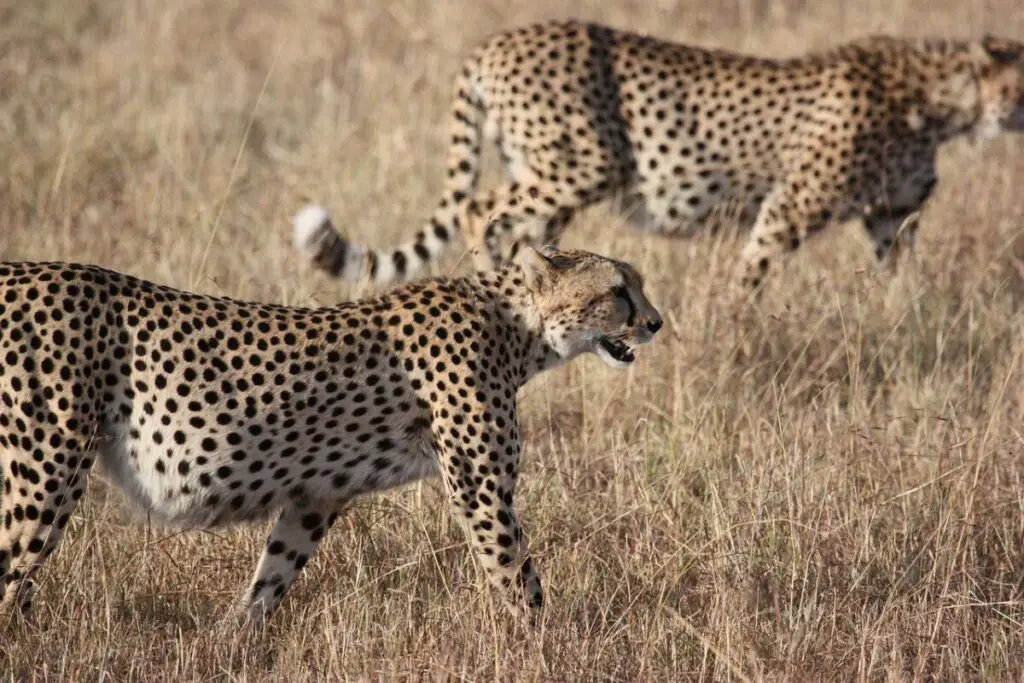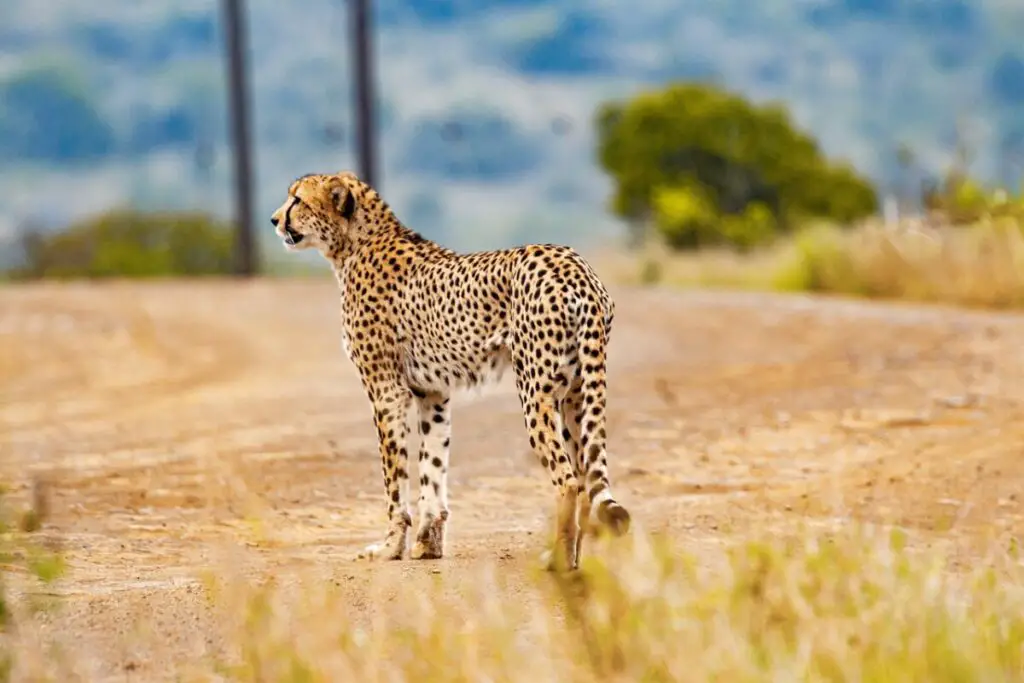Cheetahs are the world’s fastest land animal, capable of reaching speeds up to 75 miles per hour. Cheetahs have long been an object of fascination for their remarkable speed and power. As one of the most iconic predators in Africa, cheetahs play an important role in maintaining balance within the ecosystems they inhabit.
The cheetah (Acinonyx jubatus) is a large felid of the subfamily Felinae that occurs mainly in eastern and southern Africa and a few parts of Iran. It has pale yellow or tan fur with black spots on its body and can reach lengths between 4-6 feet from head to tail.
Uniquely among cats, cheetahs possess semi non-retractable claws which provide them grip while running at high velocities – allowing them to outrun almost all other animals over short distances. They also have unique facial markings such as “tear marks” which run down either side of their face; these may help reduce glare when hunting during daylight hours.
Cheetahs are active primarily during the day and hunt by sight rather than scent making them highly dependent on open habitats where prey is abundant and easily visible. The population size varies greatly across different regions, ranging from 7100–8900 individuals in South Africa alone but estimated numbers for other countries are much lower (less than 1000). With decreasing populations due to several human activities, it is clear that immediate action must be taken if we want to ensure survival of this beloved big cat.
This article will explore the biology, behavior, conservation status and future prospects for this incredible species.

Overview
The cheetah is a large cat of the family Acinonyx, native to Africa and small parts of Iran. It is the fastest land animal in the world, capable of running at speeds up to 75 mph (120 km/h). Cheetahs have an array of distinguishing features including their long legs, spotted coat pattern and deep chests. Additionally, they possess slightly rounder heads than other cats making them easily recognizable.
Cheetahs are among the most endangered species on earth with only about 7500 left in the wild. They inhabit grassy plains and savannas but due to habitat destruction and fragmentation many have been forced out from these areas into more urban regions. This has led to increased conflict between humans and cheetahs as well as competition for resources with other predators such as lions and hyenas. To ensure their survival conservation efforts must be made to protect both the cheetah’s habitats while also reducing human-wildlife conflict.
Anatomy And Appearance
The cheetah is a medium-sized cat, with an adult body length of between 3 and 4.5 feet (90 to 135 cm). Its weight ranges from 75 to 140 lbs (34 to 63 kg). The fur on its back usually has black spots in small clusters, while the rest of its coat can be yellowish or sandy brown. Its head is rounder than that of other large cats, making it easily recognizable. It also has long legs which allow it to reach high speeds when running.
Cheetahs have special adaptations for speed; their claws are semi-retractable, meaning they can still grip the ground as they run at top speed, and their tails act as a rudder allowing them to make quick turns as needed. They also possess a unique respiratory system which allows oxygen intake during extended sprints. Additionally, cheetahs’ eyesight is very sharp allowing them to spot prey even over great distances. All these features come together to create one of nature’s most impressive hunters – the fastest land animal on earth.
Cheetahs’ Predators Revealed: Unmasking the Threats
Habitat And Distribution
Cheetahs have a wide range, with populations found in sub-Saharan Africa, the Middle East and parts of Asia. They inhabit various habitats from grasslands to deserts and open woodlands. As their natural habitat is decreasing due to human activity, many cheetah populations are now restricted to protected areas such as national parks and reserves.
The major threat facing wild cheetahs is habitat loss; this has caused fragmented populations that struggle to survive outside protected areas. Other threats include poaching for illegal trade or trophy hunting, competition with other predators and humans’ persecution of them due to livestock predation. To mitigate these issues, conservation organizations are working towards increasing awareness about cheetah conservation and providing resources for local communities living alongside cheetahs.
The Swift Sensory Abilities of Cheetahs: How Good Are Their Senses?
Diet And Hunting
Cheetahs are carnivores, mainly preying on small antelopes and gazelles. They hunt by sight during the day rather than using their sense of smell like other big cats. In order to increase their chances of success when hunting, cheetahs will use a variety of strategies such as stalking and chasing prey over short distances. Cheetahs also employ group tactics in which several individuals work together to surround an animal before closing in for the kill.
The successful hunt depends highly on the individual’s physical condition; therefore, they need wide open spaces with enough room to run fast and catch their prey before it can escape. As human activity continues to reduce their natural habitats and disrupt the balance of ecosystems, this puts further pressure on already struggling wild cheetah populations.
Social Behavior
Unlike other big cats, cheetahs are not typically solitary animals. While they do live and hunt alone most of the time, they will form small groups to better their chances of finding prey. In addition, cheetah cubs stay with their mother until they reach two years old before leaving to start their own lives as adults.
The social behavior of wild cheetahs is also unique in that it includes a range of vocalizations used for communication between family members. From purrs and chirps to growls and hisses, these sounds help them communicate emotions like fear or aggression without having physical contact. Cheetahs have even been known to use facial expressions such as wrinkling their noses when communicating with one another.
Conservation Status
Cheetahs are classified as vulnerable by the International Union for Conservation of Nature (IUCN), which means they face a high risk of extinction in their natural environment. The main threats to cheetah populations include habitat loss and fragmentation, human-wildlife conflict, illegal hunting, poaching and disease. While there have been some successes in conservation efforts, such as creating protected areas or increasing awareness about protecting cheetahs, more work needs to be done if these animals are to survive in the wild.
One of the most effective ways that people can help conserve cheetahs is through ecotourism initiatives. By providing financial support from visitors who come to view them in their natural habitats, it helps fund programs like anti-poaching patrols and education campaigns that promote coexistence between humans and wildlife. It also allows local communities to benefit economically from having these animals around without putting them at risk of being killed or captured for commercial use.

Interesting Facts
Cheetahs are the world’s fastest land animals, capable of running at speeds up to 75 miles per hour. They have an extremely flexible spine that allows them to make sharp turns while chasing their prey and they can accelerate from 0-60 mph in just three seconds.
In addition to being incredibly fast runners, cheetahs also possess keen eyesight and hearing which helps them hunt effectively during the day when visibility is good. Unlike many other wild cats, cheetahs are not very territorial and will often share their habitat with other species such as antelopes or zebras. This makes it easier for them to find food if there is a shortage in one area. Furthermore, female cheetahs usually live alone and raise their cubs without help from males; this unique trait may be due to the lack of available mates because so few of these animals remain in the wild today.
Conclusion
Cheetahs are the world’s fastest land animal, reaching speeds of up to 75 miles per hour. They have long legs and a deep chest that allow them to take big strides while running. The tail is used for balance when hunting and turning quickly at high speeds. Cheetah fur also helps camouflage it as they hunt in grassy areas or on dusty plains.
Having adapted to both dry and wet habitats, cheetahs can be found across much of Africa and parts of Iran. With their incredible speed, cheetahs rely heavily on chasing down prey such as gazelles, hares, impalas, wildebeest calves, and even young ostriches. In order to conserve energy during hunts, cheetahs will sometimes stalk their prey before sprinting after them.
Although some cheetahs form coalitions with siblings or unrelated individuals for protection from predators and competition over food resources, most live solitary lives except when mating or raising cubs. Unfortunately due to habitat loss, poaching and human-wildlife conflict the population has been declining steadily since 1950’s leading IUCN (International Union for Conservation of Nature) to list cheetah as ‘Vulnerable’ species in its Red List of Threatened Species. As one of the living fossils in our planet earth research into this fascinating species needs more attention which could help us understand better about its conservation status so we can ensure future generations get an opportunity to experience these graceful animals in their natural environment.

